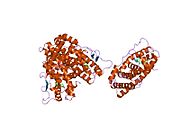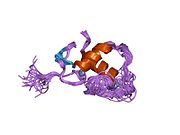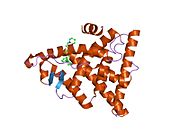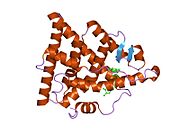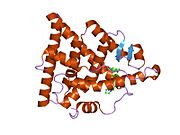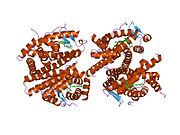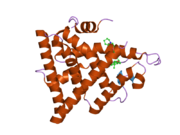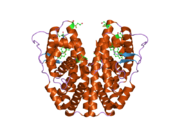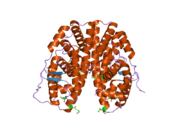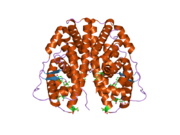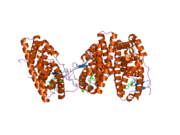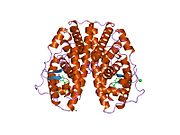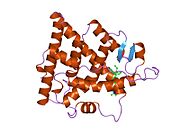Biology:Estrogen receptor alpha
 Generic protein structure example |
Estrogen receptor alpha (ERα), also known as NR3A1 (nuclear receptor subfamily 3, group A, member 1), is one of two main types of estrogen receptor, a nuclear receptor (mainly found as a chromatin-binding protein[1])
that is activated by the sex hormone estrogen. In humans, ERα is encoded by the gene ESR1 (EStrogen Receptor 1).[2][3][4]
Structure
The estrogen receptor (ER) is a ligand-activated transcription factor composed of several domains important for hormone binding, DNA binding, and activation of transcription.[5] Alternative splicing results in several ESR1 mRNA transcripts, which differ primarily in their 5-prime untranslated regions. The translated receptors show less variability.[6][7]
Ligands
Agonists
Non-selective
- Endogenous estrogens (e.g., estradiol, estrone, estriol, estetrol)
- Natural estrogens (e.g., conjugated equine estrogens)
- Synthetic estrogens (e.g., ethinylestradiol, diethylstilbestrol)
Selective
Agonists of ERα selective over ERβ include:
- Propylpyrazoletriol (PPT)
- 16α-LE2 (Cpd1471)
- 16α-IE2
- ERA-63 (ORG-37663)
- SKF-82,958 – also a D1-like receptor full agonist
- (R,R)-Tetrahydrochrysene ((R,R)-THC) – actually not selective over ERβ, but rather an antagonist instead of an agonist of ERβ
Mixed
- Phytoestrogens (e.g., coumestrol, daidzein, genistein, miroestrol)
- Selective estrogen receptor modulators (e.g., tamoxifen, clomifene, raloxifene)
Antagonists
Non-selective
- Antiestrogens (e.g., fulvestrant, ICI-164384, ethamoxytriphetol)
Selective
Antagonists of ERα selective over ERβ include:
- Methylpiperidinopyrazole (MPP)
Affinities
Tissue distribution and function
ERα plays a role in the physiological development and function of a variety of organ systems to varying degrees, including the reproductive, central nervous, skeletal, and cardiovascular systems.[8] Accordingly, ERα is widely expressed throughout the body, including the uterus and ovary, male reproductive organs, mammary gland, bone, heart, hypothalamus, pituitary gland, liver, lung, kidney, spleen, and adipose tissue.[8][9][10] The development and function of these tissues is disrupted in animal models lacking active ERα genes, such as the ERα knockout mouse (ERKO), providing a preliminary understanding of ERα function at specific target organs.[8][11]
Uterus and ovary
ERα is essential in the maturation of the female reproductive phenotype. In the absence of ERα, the ERKO mouse develops an adult uterus, indicating that ERα may not mediate the initial growth of the uterus.[8][9] However, ERα plays a role in the completion of this development, and the subsequent function of the tissue.[11] Activation of ERα is known to trigger cell proliferation in the uterus.[10] The uterus of female ERKO mice is hypoplastic, suggesting that ERα mediates mitosis and differentiation in the uterus in response to estrogen stimulation.[9]
Similarly, prepubertal female ERKO mice develop ovaries that are nearly indistinguishable from those of their wildtype counterparts. However, as the ERKO mice mature they progressively present an abnormal ovarian phenotype in both physiology and function.[9][11] Specifically, female ERKO mice develop enlarged ovaries containing hemorrhagic follicular cysts, which also lack the corpus luteum, and therefore do not ovulate.[8][9][11] This adult ovarian phenotype suggests that in the absence of ERα, estrogen is no longer able to perform negative feedback on the hypothalamus, resulting in chronically elevated LH levels and constant ovarian stimulation.[9] These results identify a pivotal role for ERα in the hypothalamus, in addition to its role in the estrogen-driven maturation through theca and interstitial cells of the ovary.[9]
Male reproductive organs
ERα is similarly essential in the maturation and maintenance of the male reproductive phenotype, as male ERKO mice are infertile and present undersized testes.[8][11] The integrity of testicular structures of ERKO mice, such as the seminiferous tubules of the testes and the seminiferous epithelium, declines over time.[8][9] Furthermore, the reproductive performance of male ERKO mice is hindered by abnormalities in sexual physiology and behavior, such as impaired spermatogenesis and loss of intromission and ejaculatory responses.[8][9]
Mammary gland
Estrogen stimulation of ERα is known to stimulate cell proliferation in breast tissue.[10] ERα is thought to be responsible for pubertal development of the adult phenotype, through mediation of mammary gland response to estrogens.[11] This role is consistent with the abnormalities of female ERKO mice: the epithelial ducts of female ERKO mice fail to grow beyond their pre-pubertal length, and lactational structures do not develop.[9] As a result, the functions of the mammary gland—including both lactation and release of prolactin—are greatly impaired in ERKO mice.[11]
Bone
Though its expression in bone is moderate, ERα is known to be responsible for maintenance of bone integrity.[10][11] It is hypothesized that estrogen stimulation of ERα may trigger the release of growth factors, such as epidermal growth factor or insulin-like growth factor-1, which in turn regulate bone development and maintenance.[11][9] Accordingly, male and female ERKO mice exhibit decreased bone length and size.[11][9]
Brain
Estrogen signaling through ERα appears to be responsible for various aspects of central nervous development, such as synaptogenesis and synaptic remodeling.[11] In the brain, ERα is found in hypothalamus, and preoptic area, and arcuate nucleus, all three of which have been linked to reproductive behavior, and the masculinization of the mouse brain appears to take place through ERα function.[8][11] Furthermore, studies in models of psychopathology and neurodegenerative disease states suggest that estrogen receptors mediate the neuroprotective role of estrogen in the brain.[8][10] Finally, ERα appears to mediate positive feedback effects of estrogen on the brain's secretion of GnRH and LH, by way increasing expression of kisspeptin in neurons of the arcuate nucleus and anteroventral periventricular nucleus.[12][13] Although classical studies have suggested that negative feedback effects of estrogen also operate through ERα, female mice lacking ERα in kisspeptin-expressing neurons continue to demonstrate a degree of negative feedback response.[14]
Clinical significance
Estrogen insensitivity syndrome is a very rare condition characterized by a defective ERα that is insensitive to estrogens.[15][16][17][18] The clinical presentation of a female was observed to include absence of breast development and other female secondary sexual characteristics at puberty, hypoplastic uterus, primary amenorrhea, enlarged multicystic ovaries and associated lower abdominal pain, mild hyperandrogenism (manifested as cystic acne), and delayed bone maturation as well as an increased rate of bone turnover.[18] The clinical presentation in a male was reported to include lack of epiphyseal closure, tall stature, osteoporosis, and poor sperm viability.[17] Both individuals were completely insensitive to exogenous estrogen treatment, even with high doses.[17][18]
Genetic polymorphisms in the gene encoding the ERα have been associated with breast cancer in women, gynecomastia in men[19][20] and dysmenorrhea.[21]
In patients with breast cancer, mutations in the gene encoding ERα (ESR1) have been associated with resistance to endocrine therapy, especially aromatase inhibitors.[22]
Coactivators
Coactivators of ER-α include:
- SRC-1[23][24]
- AIB1 – amplified in breast 1[25]
- BCAS3 – Breast carcinoma amplified sequence 3[26]
- PELP-1 – Proline-, glutamic acid-, leucine-rich protein 1[27]
Interactions
Estrogen receptor alpha has been shown to interact with:
- AKAP13[28]
- AHR[29][30]
- BRCA1[31][32][33][34]
- CAV1[35]
- CCNC[36]
- CDC25B[37]
- CEBPB[38][39]
- COBRA1[40]
- COUP-TFI[41]
- CREBBP[34][42]
- CRSP3[36]
- Cyclin D1[43]
- DDX17[44]
- DDX5[44][45]
- DNTTIP2[46]
- EP300[34][36][47]
- ESR2[48][49]
- FOXO1[50]
- GREB1[51]
- GTF2H1[52]
- HSPA1A[53]
- HSPA8[53]
- HSP90AA1[54][55]
- ISL1[56]
- JARID1A[57]
- MVP[58]
- MED1[36][59]
- MED12[36]
- MED14[36]
- MED16[36]
- MED24[36][59]
- MED6[36]
- MGMT[60]
- MNAT1[61]
- MTA1[62][63]
- NCOA6[64][65]
- NCOA1[36][42][44][66][67]
- NCOA2[44][59][68][69][70]
- NCOA3[44][71][72]
- NRIP1[73][74][75]
- PDLIM1[76]
- POU4F1[77]
- POU4F2[77]
- PRDM2[78]
- PRMT2[79]
- RBM39[80]
- RNF12[76]
- SAFB[81][82]
- SAFB2[83]
- SHC1[84]
- SHP[85][86]
- SMARCA4[66][87]
- SMARCE1[88]
- SRA1[44]
- Src[60][89][90][91]
- TR2[92]
- TR4[93]
- TDG[94]
- TRIM24[74][95] and
- XBP1.[96]
References
- ↑ "Systematic Proteomic Identification of the Heat Shock Proteins (Hsp) that Interact with Estrogen Receptor Alpha (ERα) and Biochemical Characterization of the ERα-Hsp70 Interaction". PLOS ONE 11 (8): e0160312. 2016-08-02. doi:10.1371/journal.pone.0160312. PMID 27483141. Bibcode: 2016PLoSO..1160312D.
- ↑ "Entrez Gene: ESR1 estrogen receptor 1". https://www.ncbi.nlm.nih.gov/sites/entrez?Db=gene&Cmd=ShowDetailView&TermToSearch=2099.
- ↑ "Cloning of the human estrogen receptor cDNA". Proceedings of the National Academy of Sciences of the United States of America 82 (23): 7889–7893. December 1985. doi:10.1073/pnas.82.23.7889. PMID 3865204. Bibcode: 1985PNAS...82.7889W.
- ↑ "Sequence and expression of human estrogen receptor complementary DNA". Science 231 (4742): 1150–1154. March 1986. doi:10.1126/science.3753802. PMID 3753802. Bibcode: 1986Sci...231.1150G.
- ↑ "International Union of Pharmacology. LXIV. Estrogen receptors". Pharmacological Reviews 58 (4): 773–781. December 2006. doi:10.1124/pr.58.4.8. PMID 17132854.
- ↑ "Entrez Gene: DBI diazepam binding inhibitor (GABA receptor modulator, acyl-Coenzyme A binding protein)". https://www.ncbi.nlm.nih.gov/sites/entrez?Db=gene&Cmd=ShowDetailView&TermToSearch=1622.
- ↑ "Minireview: genomic organization of the human ERalpha gene promoter region". Molecular Endocrinology 15 (12): 2057–2063. December 2001. doi:10.1210/mend.15.12.0731. PMID 11731608.
- ↑ 8.0 8.1 8.2 8.3 8.4 8.5 8.6 8.7 8.8 8.9 "Estrogen receptor signaling during vertebrate development". Biochimica et Biophysica Acta (BBA) - Gene Regulatory Mechanisms 1849 (2): 142–151. February 2015. doi:10.1016/j.bbagrm.2014.06.005. PMID 24954179.
- ↑ 9.00 9.01 9.02 9.03 9.04 9.05 9.06 9.07 9.08 9.09 9.10 9.11 "Estrogen receptor transcription and transactivation: Estrogen receptor knockout mice: what their phenotypes reveal about mechanisms of estrogen action". Breast Cancer Research 2 (5): 345–352. 2000. doi:10.1186/bcr79. PMID 11250727.
- ↑ 10.0 10.1 10.2 10.3 10.4 "Estrogen receptors alpha (ERα) and beta (ERβ): subtype-selective ligands and clinical potential". Steroids 90: 13–29. November 2014. doi:10.1016/j.steroids.2014.06.012. PMID 24971815.
- ↑ 11.00 11.01 11.02 11.03 11.04 11.05 11.06 11.07 11.08 11.09 11.10 11.11 "Functions and physiological roles of two types of estrogen receptors, ERα and ERβ, identified by estrogen receptor knockout mouse". Laboratory Animal Research 28 (2): 71–76. June 2012. doi:10.5625/lar.2012.28.2.71. PMID 22787479.
- ↑ "Effects of estradiol on kisspeptin neurons during puberty". Frontiers in Neuroendocrinology 34 (2): 120–131. April 2013. doi:10.1016/j.yfrne.2013.02.002. PMID 23500175.
- ↑ "Neurobiological mechanisms underlying oestradiol negative and positive feedback regulation of gonadotrophin-releasing hormone neurones". Journal of Neuroendocrinology 21 (4): 327–333. March 2009. doi:10.1111/j.1365-2826.2009.01826.x. PMID 19207821.
- ↑ "60 YEARS OF NEUROENDOCRINOLOGY: The hypothalamo-pituitary-gonadal axis". The Journal of Endocrinology 226 (2): T41–T54. August 2015. doi:10.1530/JOE-15-0113. PMID 25901041.
- ↑ Endocrinology: Adult and Pediatric. Elsevier Health Sciences. February 2015. pp. 238–. ISBN 978-0-323-32195-2. https://books.google.com/books?id=xmLeBgAAQBAJ&pg=PT238.
- ↑ "Estrogen receptor gene disruption: molecular characterization and experimental and clinical phenotypes". Recent Progress in Hormone Research 51: 159–86; discussion 186–8. 1996. PMID 8701078.
- ↑ 17.0 17.1 17.2 "Estrogen resistance caused by a mutation in the estrogen-receptor gene in a man". The New England Journal of Medicine 331 (16): 1056–1061. October 1994. doi:10.1056/NEJM199410203311604. PMID 8090165.
- ↑ 18.0 18.1 18.2 "Delayed puberty and estrogen resistance in a woman with estrogen receptor α variant". The New England Journal of Medicine 369 (2): 164–171. July 2013. doi:10.1056/NEJMoa1303611. PMID 23841731.
- ↑ "The Effects of Sex Protein Receptors and Sex Steroid Hormone Gene Polymorphisms on Breast Cancer Risk". Journal of the National Medical Association 109 (2): 126–138. 2017. doi:10.1016/j.jnma.2017.02.003. PMID 28599754.
- ↑ "Genetic variants of estrogen beta and leptin receptors may cause gynecomastia in adolescent". Gene 541 (2): 101–106. May 2014. doi:10.1016/j.gene.2014.03.013. PMID 24625355.
- ↑ "Estrogen receptor 1, glutathione S-transferase P1, glutathione S-transferase M1, and glutathione S-transferase T1 genes with dysmenorrhea in Korean female adolescents". The Korean Journal of Laboratory Medicine 30 (1): 76–83. February 2010. doi:10.3343/kjlm.2010.30.1.76. PMID 20197727.
- ↑ "Biomarkers for Systemic Therapy in Metastatic Breast Cancer: ASCO Guideline Update". Journal of Clinical Oncology 40 (27): 3205–3221. September 2022. doi:10.1200/JCO.22.01063. PMID 35759724.
- ↑ "Molecular determinants for the tissue specificity of SERMs". Science 295 (5564): 2465–2468. March 2002. doi:10.1126/science.1068537. PMID 11923541. Bibcode: 2002Sci...295.2465S.
- ↑ "Coregulator function: a key to understanding tissue specificity of selective receptor modulators". Endocrine Reviews 25 (1): 45–71. February 2004. doi:10.1210/er.2003-0023. PMID 14769827.
- ↑ "AIB1, a steroid receptor coactivator amplified in breast and ovarian cancer". Science 277 (5328): 965–968. August 1997. doi:10.1126/science.277.5328.965. PMID 9252329. https://zenodo.org/record/1231118.
- ↑ "Estrogen induces expression of BCAS3, a novel estrogen receptor-alpha coactivator, through proline-, glutamic acid-, and leucine-rich protein-1 (PELP1)". Molecular Endocrinology 21 (8): 1847–1860. August 2007. doi:10.1210/me.2006-0514. PMID 17505058.
- ↑ "Molecular cloning and characterization of PELP1, a novel human coregulator of estrogen receptor alpha". The Journal of Biological Chemistry 276 (41): 38272–38279. October 2001. doi:10.1074/jbc.M103783200. PMID 11481323.
- ↑ "Characterization of Brx, a novel Dbl family member that modulates estrogen receptor action". Oncogene 16 (19): 2513–2526. May 1998. doi:10.1038/sj.onc.1201783. PMID 9627117.
- ↑ "The aryl hydrocarbon receptor mediates degradation of estrogen receptor alpha through activation of proteasomes". Molecular and Cellular Biology 23 (6): 1843–1855. March 2003. doi:10.1128/MCB.23.6.1843-1855.2003. PMID 12612060.
- ↑ "The aryl hydrocarbon receptor interacts with estrogen receptor alpha and orphan receptors COUP-TFI and ERRalpha1". Archives of Biochemistry and Biophysics 373 (1): 163–174. January 2000. doi:10.1006/abbi.1999.1552. PMID 10620335.
- ↑ "BRCA1 mediates ligand-independent transcriptional repression of the estrogen receptor". Proceedings of the National Academy of Sciences of the United States of America 98 (17): 9587–9592. August 2001. doi:10.1073/pnas.171174298. PMID 11493692. Bibcode: 2001PNAS...98.9587Z.
- ↑ "Role of direct interaction in BRCA1 inhibition of estrogen receptor activity". Oncogene 20 (1): 77–87. January 2001. doi:10.1038/sj.onc.1204073. PMID 11244506.
- ↑ "Direct interaction between BRCA1 and the estrogen receptor regulates vascular endothelial growth factor (VEGF) transcription and secretion in breast cancer cells". Oncogene 21 (50): 7730–7739. October 2002. doi:10.1038/sj.onc.1205971. PMID 12400015.
- ↑ 34.0 34.1 34.2 "p300 Modulates the BRCA1 inhibition of estrogen receptor activity". Cancer Research 62 (1): 141–151. January 2002. PMID 11782371.
- ↑ "Ligand-independent activation of oestrogen receptor alpha by caveolin-1". The Biochemical Journal 359 (Pt 1): 203–210. October 2001. doi:10.1042/0264-6021:3590203. PMID 11563984.
- ↑ 36.0 36.1 36.2 36.3 36.4 36.5 36.6 36.7 36.8 36.9 "The TRAP/Mediator coactivator complex interacts directly with estrogen receptors alpha and beta through the TRAP220 subunit and directly enhances estrogen receptor function in vitro". Proceedings of the National Academy of Sciences of the United States of America 99 (5): 2642–2647. March 2002. doi:10.1073/pnas.261715899. PMID 11867769. Bibcode: 2002PNAS...99.2642K.
- ↑ "Cdc25B functions as a novel coactivator for the steroid receptors". Molecular and Cellular Biology 21 (23): 8056–8067. December 2001. doi:10.1128/MCB.21.23.8056-8067.2001. PMID 11689696.
- ↑ "AF-2-dependent potentiation of CCAAT enhancer binding protein beta-mediated transcriptional activation by glucocorticoid receptor". Molecular Endocrinology 12 (11): 1749–1763. November 1998. doi:10.1210/mend.12.11.0191. PMID 9817600.
- ↑ "Repression of the interleukin-6 promoter by estrogen receptor is mediated by NF-kappa B and C/EBP beta". Molecular and Cellular Biology 15 (9): 4971–4979. September 1995. doi:10.1128/MCB.15.9.4971. PMID 7651415.
- ↑ "Attenuation of estrogen receptor alpha-mediated transcription through estrogen-stimulated recruitment of a negative elongation factor". Genes & Development 18 (17): 2134–2146. September 2004. doi:10.1101/gad.1214104. PMID 15342491.
- ↑ "Formation of an hER alpha-COUP-TFI complex enhances hER alpha AF-1 through Ser118 phosphorylation by MAPK". The EMBO Journal 21 (13): 3443–3453. July 2002. doi:10.1093/emboj/cdf344. PMID 12093745.
- ↑ 42.0 42.1 "Analysis of the steroid receptor coactivator 1 (SRC1)-CREB binding protein interaction interface and its importance for the function of SRC1". Molecular and Cellular Biology 21 (1): 39–50. January 2001. doi:10.1128/MCB.21.1.39-50.2001. PMID 11113179.
- ↑ "CDK-independent activation of estrogen receptor by cyclin D1". Cell 88 (3): 405–415. February 1997. doi:10.1016/S0092-8674(00)81879-6. PMID 9039267.
- ↑ 44.0 44.1 44.2 44.3 44.4 44.5 "A subfamily of RNA-binding DEAD-box proteins acts as an estrogen receptor alpha coactivator through the N-terminal activation domain (AF-1) with an RNA coactivator, SRA". The EMBO Journal 20 (6): 1341–1352. March 2001. doi:10.1093/emboj/20.6.1341. PMID 11250900.
- ↑ "Purification and identification of p68 RNA helicase acting as a transcriptional coactivator specific for the activation function 1 of human estrogen receptor alpha". Molecular and Cellular Biology 19 (8): 5363–5372. August 1999. doi:10.1128/MCB.19.8.5363. PMID 10409727.
- ↑ "ERBP, a novel estrogen receptor binding protein enhancing the activity of estrogen receptor". Biochemical and Biophysical Research Communications 317 (1): 54–59. April 2004. doi:10.1016/j.bbrc.2004.02.179. PMID 15047147.
- ↑ "The retinoblastoma-histone deacetylase 3 complex inhibits PPARgamma and adipocyte differentiation". Developmental Cell 3 (6): 903–910. December 2002. doi:10.1016/S1534-5807(02)00360-X. PMID 12479814.
- ↑ "The complete primary structure of human estrogen receptor beta (hER beta) and its heterodimerization with ER alpha in vivo and in vitro". Biochemical and Biophysical Research Communications 243 (1): 122–126. February 1998. doi:10.1006/bbrc.1997.7893. PMID 9473491.
- ↑ "Specific association of estrogen receptor beta with the cell cycle spindle assembly checkpoint protein, MAD2". Proceedings of the National Academy of Sciences of the United States of America 97 (6): 2836–2839. March 2000. doi:10.1073/pnas.050580997. PMID 10706629. Bibcode: 2000PNAS...97.2836P.
- ↑ "Ligand-dependent interaction of estrogen receptor-alpha with members of the forkhead transcription factor family". The Journal of Biological Chemistry 276 (36): 33554–33560. September 2001. doi:10.1074/jbc.M105555200. PMID 11435445.
- ↑ "Regulation of GREB1 transcription by estrogen receptor alpha through a multipartite enhancer spread over 20 kb of upstream flanking sequences". The Journal of Biological Chemistry 282 (24): 17335–17339. June 2007. doi:10.1074/jbc.C700030200. PMID 17463000.
- ↑ "Activation of estrogen receptor alpha by S118 phosphorylation involves a ligand-dependent interaction with TFIIH and participation of CDK7". Molecular Cell 6 (1): 127–137. July 2000. doi:10.1016/S1097-2765(00)00014-9. PMID 10949034.
- ↑ 53.0 53.1 "Systematic Proteomic Identification of the Heat Shock Proteins (Hsp) that Interact with Estrogen Receptor Alpha (ERα) and Biochemical Characterization of the ERα-Hsp70 Interaction". PLOS ONE 11 (8): e0160312. 2016. doi:10.1371/journal.pone.0160312. PMID 27483141. Bibcode: 2016PLoSO..1160312D.
- ↑ "A pathway of multi-chaperone interactions common to diverse regulatory proteins: estrogen receptor, Fes tyrosine kinase, heat shock transcription factor Hsf1, and the aryl hydrocarbon receptor". Cell Stress & Chaperones 1 (4): 237–250. December 1996. PMID 9222609.
- ↑ "Radicicol represses the transcriptional function of the estrogen receptor by suppressing the stabilization of the receptor by heat shock protein 90". Molecular and Cellular Endocrinology 188 (1–2): 47–54. February 2002. doi:10.1016/S0303-7207(01)00753-5. PMID 11911945.
- ↑ "The LIM/homeodomain protein islet-1 modulates estrogen receptor functions". Molecular Endocrinology 14 (10): 1627–1648. October 2000. doi:10.1210/mend.14.10.0538. PMID 11043578.
- ↑ "Retinoblastoma-binding protein 2 (Rbp2) potentiates nuclear hormone receptor-mediated transcription". The Journal of Biological Chemistry 276 (30): 28402–28412. July 2001. doi:10.1074/jbc.M100313200. PMID 11358960.
- ↑ "Interaction of vault particles with estrogen receptor in the MCF-7 breast cancer cell". The Journal of Cell Biology 141 (6): 1301–1310. June 1998. doi:10.1083/jcb.141.6.1301. PMID 9628887.
- ↑ 59.0 59.1 59.2 "The chromatin-remodeling complex WINAC targets a nuclear receptor to promoters and is impaired in Williams syndrome". Cell 113 (7): 905–917. June 2003. doi:10.1016/S0092-8674(03)00436-7. PMID 12837248.
- ↑ 60.0 60.1 "The modified human DNA repair enzyme O(6)-methylguanine-DNA methyltransferase is a negative regulator of estrogen receptor-mediated transcription upon alkylation DNA damage". Molecular and Cellular Biology 21 (20): 7105–7114. October 2001. doi:10.1128/MCB.21.20.7105-7114.2001. PMID 11564893.
- ↑ "MTA1 interacts with MAT1, a cyclin-dependent kinase-activating kinase complex ring finger factor, and regulates estrogen receptor transactivation functions". The Journal of Biological Chemistry 278 (13): 11676–11685. March 2003. doi:10.1074/jbc.M209570200. PMID 12527756.
- ↑ "A naturally occurring MTA1 variant sequesters oestrogen receptor-alpha in the cytoplasm". Nature 418 (6898): 654–657. August 2002. doi:10.1038/nature00889. PMID 12167865. Bibcode: 2002Natur.418..654K.
- ↑ "Transcriptional repression of oestrogen receptor by metastasis-associated protein 1 corepressor". Nature Cell Biology 3 (1): 30–37. January 2001. doi:10.1038/35050532. PMID 11146623.
- ↑ "A nuclear factor, ASC-2, as a cancer-amplified transcriptional coactivator essential for ligand-dependent transactivation by nuclear receptors in vivo". The Journal of Biological Chemistry 274 (48): 34283–34293. November 1999. doi:10.1074/jbc.274.48.34283. PMID 10567404.
- ↑ "Ser-884 adjacent to the LXXLL motif of coactivator TRBP defines selectivity for ERs and TRs". Molecular Endocrinology 16 (1): 128–140. January 2002. doi:10.1210/mend.16.1.0755. PMID 11773444.
- ↑ 66.0 66.1 "BRG-1 is recruited to estrogen-responsive promoters and cooperates with factors involved in histone acetylation". Molecular and Cellular Biology 20 (20): 7541–7549. October 2000. doi:10.1128/MCB.20.20.7541-7549.2000. PMID 11003650.
- ↑ "Isoforms of steroid receptor co-activator 1 differ in their ability to potentiate transcription by the oestrogen receptor". The EMBO Journal 17 (1): 232–243. January 1998. doi:10.1093/emboj/17.1.232. PMID 9427757.
- ↑ "Interaction of transcriptional intermediary factor 2 nuclear receptor box peptides with the coactivator binding site of estrogen receptor alpha". The Journal of Biological Chemistry 277 (24): 21862–21868. June 2002. doi:10.1074/jbc.M200764200. PMID 11937504.
- ↑ "Electrostatic modulation in steroid receptor recruitment of LXXLL and FXXLF motifs". Molecular and Cellular Biology 23 (6): 2135–2150. March 2003. doi:10.1128/MCB.23.6.2135-2150.2003. PMID 12612084.
- ↑ "Recruitment of coactivator glucocorticoid receptor interacting protein 1 to an estrogen receptor transcription complex is regulated by the 3',5'-cyclic adenosine 5'-monophosphate-dependent protein kinase". Endocrinology 149 (9): 4336–4345. September 2008. doi:10.1210/en.2008-0037. PMID 18499756.
- ↑ "Structure-function evaluation of ER alpha and beta interplay with SRC family coactivators. ER selective ligands". Biochemistry 40 (23): 6756–6765. June 2001. doi:10.1021/bi010379h. PMID 11389589.
- ↑ "Endogenously expressed estrogen receptor and coactivator AIB1 interact in MCF-7 human breast cancer cells". Proceedings of the National Academy of Sciences of the United States of America 97 (23): 12536–12540. November 2000. doi:10.1073/pnas.220427297. PMID 11050174. Bibcode: 2000PNAS...9712536T.
- ↑ "Nuclear factor RIP140 modulates transcriptional activation by the estrogen receptor". The EMBO Journal 14 (15): 3741–3751. August 1995. doi:10.1002/j.1460-2075.1995.tb00044.x. PMID 7641693.
- ↑ 74.0 74.1 "Differential interaction of nuclear receptors with the putative human transcriptional coactivator hTIF1". The Journal of Biological Chemistry 272 (18): 12062–12068. May 1997. doi:10.1074/jbc.272.18.12062. PMID 9115274.
- ↑ "RIP-140 interacts with multiple nuclear receptors by means of two distinct sites". Molecular and Cellular Biology 16 (11): 6029–6036. November 1996. doi:10.1128/MCB.16.11.6029. PMID 8887632.
- ↑ 76.0 76.1 "Regulation of estrogen-dependent transcription by the LIM cofactors CLIM and RLIM in breast cancer". Cancer Research 69 (1): 128–136. January 2009. doi:10.1158/0008-5472.CAN-08-1630. PMID 19117995.
- ↑ 77.0 77.1 "POU transcription factors Brn-3a and Brn-3b interact with the estrogen receptor and differentially regulate transcriptional activity via an estrogen response element". Molecular and Cellular Biology 18 (2): 1029–1041. February 1998. doi:10.1128/mcb.18.2.1029. PMID 9448000.
- ↑ "The retinoblastoma-interacting zinc-finger protein RIZ is a downstream effector of estrogen action". Proceedings of the National Academy of Sciences of the United States of America 97 (7): 3130–3135. March 2000. doi:10.1073/pnas.050015697. PMID 10706618.
- ↑ "Identification of protein arginine methyltransferase 2 as a coactivator for estrogen receptor alpha". The Journal of Biological Chemistry 277 (32): 28624–28630. August 2002. doi:10.1074/jbc.M201053200. PMID 12039952.
- ↑ "Molecular cloning and characterization of CAPER, a novel coactivator of activating protein-1 and estrogen receptors". The Journal of Biological Chemistry 277 (2): 1229–1234. January 2002. doi:10.1074/jbc.M110417200. PMID 11704680.
- ↑ "Structure-function analysis of the estrogen receptor alpha corepressor scaffold attachment factor-B1: identification of a potent transcriptional repression domain". The Journal of Biological Chemistry 279 (25): 26074–26081. June 2004. doi:10.1074/jbc.M313726200. PMID 15066997.
- ↑ "Tamoxifen-bound estrogen receptor (ER) strongly interacts with the nuclear matrix protein HET/SAF-B, a novel inhibitor of ER-mediated transactivation". Molecular Endocrinology 14 (3): 369–381. March 2000. doi:10.1210/mend.14.3.0432. PMID 10707955.
- ↑ "SAFB2, a new scaffold attachment factor homolog and estrogen receptor corepressor". The Journal of Biological Chemistry 278 (22): 20059–20068. May 2003. doi:10.1074/jbc.M212988200. PMID 12660241.
- ↑ "Linkage of rapid estrogen action to MAPK activation by ERalpha-Shc association and Shc pathway activation". Molecular Endocrinology 16 (1): 116–127. January 2002. doi:10.1210/mend.16.1.0748. PMID 11773443.
- ↑ "Inhibition of estrogen receptor action by the orphan receptor SHP (short heterodimer partner)". Molecular Endocrinology 12 (10): 1551–1557. October 1998. doi:10.1210/mend.12.10.0184. PMID 9773978.
- ↑ "The agonist activity of tamoxifen is inhibited by the short heterodimer partner orphan nuclear receptor in human endometrial cancer cells". Endocrinology 143 (3): 853–867. March 2002. doi:10.1210/endo.143.3.8676. PMID 11861507.
- ↑ "Ligand-dependent interaction between the estrogen receptor and the human homologues of SWI2/SNF2". Gene 188 (1): 95–100. March 1997. doi:10.1016/S0378-1119(96)00785-8. PMID 9099865.
- ↑ "Targeting of SWI/SNF chromatin remodelling complexes to estrogen-responsive genes". The EMBO Journal 21 (15): 4094–4103. August 2002. doi:10.1093/emboj/cdf412. PMID 12145209.
- ↑ "Steroid-induced androgen receptor-oestradiol receptor beta-Src complex triggers prostate cancer cell proliferation". The EMBO Journal 19 (20): 5406–5417. October 2000. doi:10.1093/emboj/19.20.5406. PMID 11032808.
- ↑ "Activating signal cointegrator 1, a novel transcription coactivator of nuclear receptors, and its cytosolic localization under conditions of serum deprivation". Molecular and Cellular Biology 19 (9): 6323–6332. September 1999. doi:10.1128/mcb.19.9.6323. PMID 10454579.
- ↑ "Identification of the human Mnk2 gene (MKNK2) through protein interaction with estrogen receptor beta". Genomics 69 (1): 63–71. October 2000. doi:10.1006/geno.2000.6299. PMID 11013076.
- ↑ "Suppression of estrogen receptor-mediated transcription and cell growth by interaction with TR2 orphan receptor". The Journal of Biological Chemistry 277 (37): 33571–33579. September 2002. doi:10.1074/jbc.M203531200. PMID 12093804.
- ↑ "Modulation of estrogen receptor-mediated transactivation by orphan receptor TR4 in MCF-7 cells". The Journal of Biological Chemistry 277 (17): 14622–14628. April 2002. doi:10.1074/jbc.M110051200. PMID 11844790.
- ↑ "T:G mismatch-specific thymine-DNA glycosylase potentiates transcription of estrogen-regulated genes through direct interaction with estrogen receptor alpha". The Journal of Biological Chemistry 278 (40): 38586–38592. October 2003. doi:10.1074/jbc.M304286200. PMID 12874288.
- ↑ "Effect of ligand and DNA binding on the interaction between human transcription intermediary factor 1alpha and estrogen receptors". Molecular Endocrinology 13 (12): 2137–2150. December 1999. doi:10.1210/mend.13.12.0387. PMID 10598587.
- ↑ "Ligand-independent activation of estrogen receptor alpha by XBP-1". Nucleic Acids Research 31 (18): 5266–5274. September 2003. doi:10.1093/nar/gkg731. PMID 12954762.
Further reading
- "Connections and regulation of the human estrogen receptor". Science 296 (5573): 1642–1644. May 2002. doi:10.1126/science.1071884. PMID 12040178. Bibcode: 2002Sci...296.1642M.
- "Novel non-transcriptional mechanisms for estrogen receptor signaling in the cardiovascular system. Interaction of estrogen receptor alpha with phosphatidylinositol 3-OH kinase". Steroids 67 (12): 935–939. November 2002. doi:10.1016/S0039-128X(02)00040-5. PMID 12398989.
- "Estrogen receptor phosphorylation". Steroids 68 (1): 1–9. January 2003. doi:10.1016/S0039-128X(02)00110-1. PMID 12475718.
- "Role of estrogen receptor-alpha in pharmacogenetics of estrogen action". Current Opinion in Lipidology 14 (2): 145–150. April 2003. doi:10.1097/00041433-200304000-00005. PMID 12642782.
- "Estrogen receptor alpha polymorphisms and renal cell carcinoma--a possible risk". Molecular and Cellular Endocrinology 202 (1–2): 109–116. April 2003. doi:10.1016/S0303-7207(03)00071-6. PMID 12770739.
- "Estrogen receptor alpha in human breast cancer: occurrence and significance". Journal of Mammary Gland Biology and Neoplasia 5 (3): 271–281. July 2000. doi:10.1023/A:1009594727358. PMID 14973389.
- "Estrogen receptor content in malignant breast tumors in men--a review". Journal of Mammary Gland Biology and Neoplasia 5 (3): 283–287. July 2000. doi:10.1023/A:1009546811429. PMID 14973390.
- "Role of estrogen receptor alpha in modulating IGF-I receptor signaling and function in breast cancer". Journal of Experimental & Clinical Cancer Research 23 (3): 385–394. September 2004. PMID 15595626.
- "Requirements for estrogen receptor alpha membrane localization and function". Steroids 70 (5–7): 361–363. 2005. doi:10.1016/j.steroids.2005.02.015. PMID 15862818.
- "Association of estrogen receptor alpha gene polymorphisms with bone mineral density in Chinese women: a meta-analysis". Osteoporosis International 18 (3): 295–305. March 2007. doi:10.1007/s00198-006-0239-2. PMID 17089081.
- "Sequence analysis of the 5' flanking region of the human estrogen receptor gene". DNA Sequence 2 (6): 347–358. 1992. doi:10.3109/10425179209020816. PMID 1476547.
- "Analysis of upstream sequences of the human estrogen receptor gene". Biochemical and Biophysical Research Communications 183 (3): 996–1002. March 1992. doi:10.1016/S0006-291X(05)80289-X. PMID 1567414.
- "Characterization of a temperature-sensitive mutation in the hormone binding domain of the human estrogen receptor. Studies in cell extracts and intact cells and their implications for hormone-dependent transcriptional activation". The Journal of Biological Chemistry 267 (14): 9868–9873. May 1992. doi:10.1016/S0021-9258(19)50174-0. PMID 1577818.
- "Characterization of estrogen receptor variant mRNAs from human breast cancers". Molecular Endocrinology 6 (5): 773–785. May 1992. doi:10.1210/mend.6.5.1603086. PMID 1603086.
- "Evidence for a previously unidentified upstream exon in the human oestrogen receptor gene". Journal of Molecular Endocrinology 6 (1): 111–115. February 1991. doi:10.1677/jme.0.0060111. PMID 2015052.
- "Mutagenesis of cysteines in the hormone binding domain of the human estrogen receptor. Alterations in binding and transcriptional activation by covalently and reversibly attaching ligands". The Journal of Biological Chemistry 266 (17): 10880–10887. June 1991. doi:10.1016/S0021-9258(18)99101-5. PMID 2040605.
- "Solution structure of the DNA-binding domain of the oestrogen receptor". Nature 348 (6300): 458–461. November 1990. doi:10.1038/348458a0. PMID 2247153. Bibcode: 1990Natur.348..458S.
- "The cloned human oestrogen receptor contains a mutation which alters its hormone binding properties". The EMBO Journal 8 (7): 1981–1986. July 1989. doi:10.1002/j.1460-2075.1989.tb03604.x. PMID 2792078.
- "Genomic organization of the human oestrogen receptor gene". The EMBO Journal 7 (11): 3385–3388. November 1988. doi:10.1002/j.1460-2075.1988.tb03211.x. PMID 3145193.
- "Sequence and expression of human estrogen receptor complementary DNA". Science 231 (4742): 1150–1154. March 1986. doi:10.1126/science.3753802. PMID 3753802. Bibcode: 1986Sci...231.1150G.
External links
- FactorBook ERalpha_a
- Overview of all the structural information available in the PDB for UniProt: P03372 (Estrogen receptor) at the PDBe-KB.
This article incorporates text from the United States National Library of Medicine, which is in the public domain.
 |



